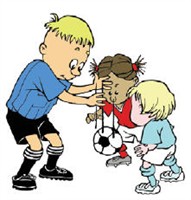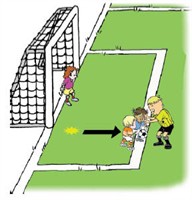KICK-OFF
The kick-off is one of eight ways to start or restart a soccer match. To start the game, start the second half, start any period of extra time or restart play after a goal, the attacking team gets a kick-off.
SINCE 1863
The kick-off has survived the test of time. The original Laws of the Game, codified in a London pub in December, 1863, said "The game shall be commenced by a place kick from the center of the ground by the side winning the toss, the other side shall not approach within 10 yards of the ball until it is kicked off. After a goal is won the losing side shall be entitled to a kick-off." So the provisions of the kick-off are virtually unchanged after more than 125 years. About the only change was the removal of the provision that "the two sides shall change goals after each goal is won."
|
SIMPLICITY
All players in their own half of the field. No opponents within 10 yards of the ball. Make sure everyone is ready. Start your watch and make sure it is running before you signal. Give the signal for start. That is not a difficult restart to manage.
REFEREE'S ROLES
For the start of play, it is usual for the trail referee to cover the ball, the kicker, the taking of the kick and encroachment. Whatever position the referee takes should allow the referee to move quickly to a position for judging offside as soon as the play begins.
OTHERS ASPECTS TO MANAGE
Your game management must not fall by the wayside during that facet of the game. You need eye contact with your fellow referee(s), you need to scan the field to look for hot spots and displeased players. Since the ball is not in play, it serves a perfect time for you to have quiet word with a player regarding improper behavior. Maybe that player just had a go at your fellow referee regarding an offside decision. Stand near the player and quietly and privately explain you will protect your teammate just as strongly as the player will act to protect his teammates. Order the kick-off taken from your spot near the player and offer some encouraging words as the ball is put in play.
SOME TRY TO GAIN AN ADVANTAGE
In a cyclical pattern, teams in one area reinvent the wheel and brink back an illegal technique that has been going on for decades. Most often it's the youthful players who figure it out for themselves or viewed someone else try it and get away with it - one of the wingers will get a 10-15 yard start before the ball is kicked off, the two players in the center circle legally place the ball into play and the second player to touch the ball whacks it 40 yards to open space behind the defenders. If you see it, whistle it and order the retake. If you sense it happening, watch the entire length of the halfway line immediately before signaling for the restart.
|
DROPPED BALL  A dropped ball is a way of restarting the match after a temporary stoppage which becomes necessary, while the ball is in play, for any reasons not mentioned elsewhere in the Laws of the Game. While injury tends to be the most common reason for such stoppages, inadvertent whistles, burst balls, toddlers and animals are possibilities during your games. HISTORICAL LOOK AT INJURY MANAGEMENTDennis Howell was a Football League ( England) referee for almost 20 years, and in 1955, was elected to Parliament. In 1964, he was appointed his nation's first Minister of Sport. Howell wrote Soccer Refereeing(c 1968, Pelham Books, London). In that book, he described the days leading up to the 1966 World Cup, held in England: "Another subject that came up early, following incidents on the field of play, concerned injured players. At first a host of officials would charge onto the field, but with Mr. (Ken) Aston in the chair (of the FIFA referee committee) the referees decided they would agree to two attendants coming on to the field, and FIFA then dispatched a telex containing this decision to each of teams at their various headquarters throughout the country." Many years after that historic World Cup, the guidance remains mush the same. Quoting a Memorandum on instructions for referees and resolutions affecting team managers and players from In the Eye of the Whistle II: The Refereeing at the 1990 World Cup, page 142 says: Coaches, Trainers, Doctors - Coaching players during a game is permitted from the team's bench.
- Only two team officials may enter the field when called upon by the referee in the case of injury of a player.
- An injured player may not be treated on the filed of play. If necessary, he shall be removed by stretcher.
- The two officials are permitted to enter the field of play solely for the purpose of assessing an injury not to treat it - and to arrange for his removal, if necessary. In these circumstances, only a minimum of first-aid equipment should be carried onto the field."
|
COMMON SENSE
You are not going to stop the mother of a small child from entering a field, even if she is the third representative of that team to step onto the field. On local parks, it is wise to know what the guidance is so you can prevent an excess by calling upon the guidance but do not get heavy-handed during a recreational game when there is the possibility of serious injury. Err on the side of safety.
INJURIES
Many referees misunderstand dealing with an injured player. Many referees do not properly manage that aspect of the game because of their lack of concentration on play and the game. There are obvious differences in dealing with injured players at professional levels, school levels and at youth play. For example, two players bang heads in mid-air in the penalty area. As soon as they fall down, blow the whistle, stop play and summon help. If you don't stop the contest and one player is down but the opponents continue to play, look for a very angry teammate to come down hard on the ankles of an opponent to cause a foul. In the mind of the player committing the foul, at lease that stops the game for the teammate to be tended to.
What caused the player to go down? Was it a collision with a teammate, an opponent, a goalpost or the advertising boards? Was there a fair or foul tackle or challenge? What is the location of continuing play? What is the score? What is the style of play? All those and more play a crucial role in determining the way you act when a player goes down.
There is no single answer to the complex web of scenarios. The generally acceptable guidelines: - The higher the level of play, the more likely you might wait a few seconds for the players to kick the ball out. The farther the ball is from the penalty area, the faster the stoppage comes.
- The younger or less skillful the players, the faster the whistle needs to be blown. Since most referees are involved in youth soccer, it is safer to hit the whistle and summon the coaches to do their part.
The parents and coaches will forgive you if a decent scoring chance was wasted due to your prompt stoppage. Watch parents and coaches disagree with the immediate halt to play. On the other hand, watch referees get screamed at, even by the injured player's coaches and parents for allowing the team to play and score while their own player is down in pain.
|
SPECIAL CIRCUMSTANCES
A dropped ball is one of two cases when a ball is moved to a location six yards from the goal-line when the restart was within the goal area.
BALL IN PLAY
The dropped ball is the only one of the eight restarts that is not restarted by a player. The referee starts the play and the ball is not in play until it touches the ground. If a player touches the ball before the ball strikes the ground, the ball must be re-dropped.
NUMBER OF PLAYERS INVOLVED
Since equality is one of the tenets of the spirit of the game, it is customary to have one player from each team participate in the dropped ball. However, it is a mistaken assumption that all dropped balls must be conducted in that manner. There is now requirement that players from both teams - or that any player - must take part at a dropped ball. Be fair but do what you think is right, given the circumstances.
|

|
 |